1. Moses AM, Miller M. Drug-induced dilutional hyponatremia. N Engl J Med. 1974; 291:1234–1239. PMID:
4607502.

2. Steele TH, Serpick AA, Block JB. Antidiuretic response to cyclophosphamide in man. J Pharmacol Exp Ther. 1973; 185:245–253. PMID:
4703820.
3. Koo TY, Bae SC, Park JS, et al. Water intoxication following low-dose intravenous cyclophosphamide. Electrolyte Blood Press. 2007; 5:50–54.

4. Lee YC, Park JS, Lee CH, et al. Hyponatraemia induced by low-dose intravenous pulse cyclophosphamide. Nephrol Dial Transplant. 2010; 25:1520–1524. PMID:
20007128.

5. Nielsen S, Agre P. The aquaporin family of water channels in kidney. Kidney Int. 1995; 48:1057–1068. PMID:
8569067.

6. Nielsen S, DiGiovanni SR, Christensen EI, Knepper MA, Harris HW. Cellular and subcellular immunolocalization of vasopressin-regulated water channel in rat kidney. Proc Natl Acad Sci U S A. 1993; 90:11663–11667. PMID:
8265605.

7. Lee YJ, Han HJ. Troglitazone ameliorates high glucose-induced EMT and dysfunction of SGLTs through PI3K/Akt, GSK-3{beta}, Snail1, and {beta}-catenin in renal proximal tubule cells. Am J Physiol Renal Physiol. 2010; 298:F1263–F1275.
8. Bodo E, Tobin DJ, Kamenisch Y, et al. Dissecting the impact of chemotherapy on the human hair follicle: a pragmatic in vitro assay for studying the pathogenesis and potential management of hair follicle dystrophy. Am J Pathol. 2007; 171:1153–1167. PMID:
17823286.
9. Flowers JL, Ludeman SM, Gamcsik MP, et al. Evidence for a role of chloroethylaziridine in the cytotoxicity of cyclophosphamide. Cancer Chemother Pharmacol. 2000; 45:335–344. PMID:
10755323.

10. Anderson LW, Ludeman SM, Colvin OM, Grochow LB, Strong JM. Quantitation of 4-hydroxycyclophosphamide/aldophosphamide in whole blood. J Chromatogr B Biomed Appl. 1995; 667:247–257. PMID:
7663697.

11. Anderson LW, Chen TL, Colvin OM, et al. Cyclophosphamide and 4-Hydroxycyclophosphamide/aldophosphamide kinetics in patients receiving high-dose cyclophosphamide chemotherapy. Clin Cancer Res. 1996; 2:1481–1487. PMID:
9816324.
12. Chen TL, Kennedy MJ, Anderson LW, et al. Nonlinear pharmacokinetics of cyclophosphamide and 4-hydroxycyclophosphamide/aldophosphamide in patients with metastatic breast cancer receiving high-dose chemotherapy followed by autologous bone marrow transplantation. Drug Metab Dispos. 1997; 25:544–551. PMID:
9152592.
13. Bradford MM. A rapid and sensitive method for the quantitation of microgram quantities of protein utilizing the principle of protein-dye binding. Anal Biochem. 1976; 72:248–254. PMID:
942051.

14. Lee CH, Kim S, Kang CM, Kim WY, Kim J, Kim GH. Altered expression of tight junction proteins in cyclosporine nephrotoxicity. Am J Nephrol. 2011; 33:7–16. PMID:
21124021.

15. Sonoda H, Yokota-Ikeda N, Oshikawa S, et al. Decreased abundance of urinary exosomal aquaporin-1 in renal ischemia-reperfusion injury. Am J Physiol Renal Physiol. 2009; 297:F1006–F1016. PMID:
19640902.

16. Kishore BK, Mandon B, Oza NB, et al. Rat renal arcade segment expresses vasopressin-regulated water channel and vasopressin V2 receptor. J Clin Invest. 1996; 97:2763–2771. PMID:
8675687.

17. Nejsum LN, Elkjaer M, Hager H, Frokiaer J, Kwon TH, Nielsen S. Localization of aquaporin-7 in rat and mouse kidney using RT-PCR, immunoblotting, and immunocytochemistry. Biochem Biophys Res Commun. 2000; 277:164–170. PMID:
11027658.

18. Sarmiento JM, Ehrenfeld P, Anazco CC, et al. Differential distribution of the vasopressin V receptor along the rat nephron during renal ontogeny and maturation. Kidney Int. 2005; 68:487–496. PMID:
16014025.
19. Terris J, Ecelbarger CA, Nielsen S, Knepper MA. Long-term regulation of four renal aquaporins in rats. Am J Physiol. 1996; 271:F414–F422. PMID:
8770174.

20. Liamis G, Milionis H, Elisaf M. A review of drug-induced hyponatremia. Am J Kidney Dis. 2008; 52:144–153. PMID:
18468754.

21. Bode U, Seif SM, Levine AS. Studies on the antidiuretic effect of cyclophosphamide: vasopressin release and sodium excretion. Med Pediatr Oncol. 1980; 8:295–303. PMID:
7464688.

22. Bressler RB, Huston DP. Water intoxication following moderate-dose intravenous cyclophosphamide. Arch Intern Med. 1985; 145:548–549. PMID:
3977522.

23. Campbell DM, Atkinson A, Gillis D, Sochett EB. Cyclophosphamide and water retention: mechanism revisited. J Pediatr Endocrinol Metab. 2000; 13:673–675. PMID:
10905395.

24. Kahn T. Reset osmostat and salt and water retention in the course of severe hyponatremia. Medicine (Baltimore). 2003; 82:170–176. PMID:
12792303.

25. DeFronzo RA, Braine H, Colvin M, Davis PJ. Water intoxication in man after cyclophosphamide therapy. Time course and relation to drug activation. Ann Intern Med. 1973; 78:861–869. PMID:
4713567.
26. de Bragança AC, Moyses ZP, Magaldi AJ. Carbamazepine can induce kidney water absorption by increasing aquaporin 2 expression. Nephrol Dial Transplant. 2010; 25:3840–3845. PMID:
20525972.
27. Ishibashi K, Imai M, Sasaki S. Cellular localization of aquaporin 7 in the rat kidney. Exp Nephrol. 2000; 8:252–257. PMID:
10940724.

28. Nejsum LN, Elkjaer M, Hager H, Frokiaer J, Kwon TH, Nielsen S. Localization of aquaporin-7 in rat and mouse kidney using RT-PCR, immunoblotting, and immunocytochemistry. Biochem Biophys Res Commun. 2000; 277:164–170. PMID:
11027658.

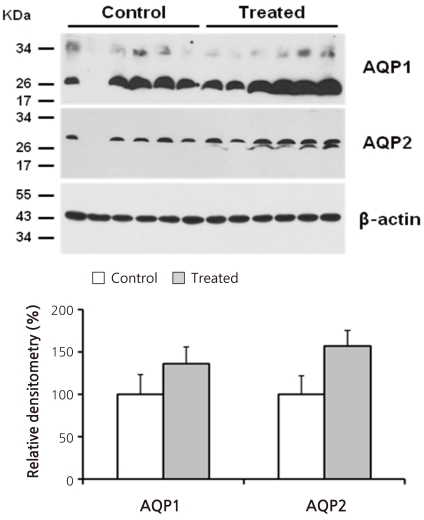
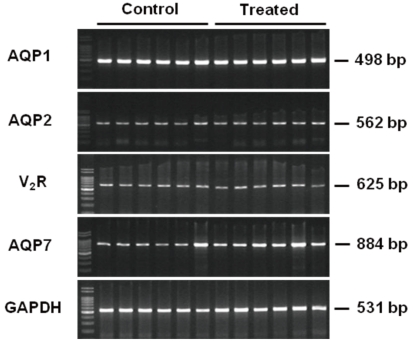




 PDF
PDF ePub
ePub Citation
Citation Print
Print



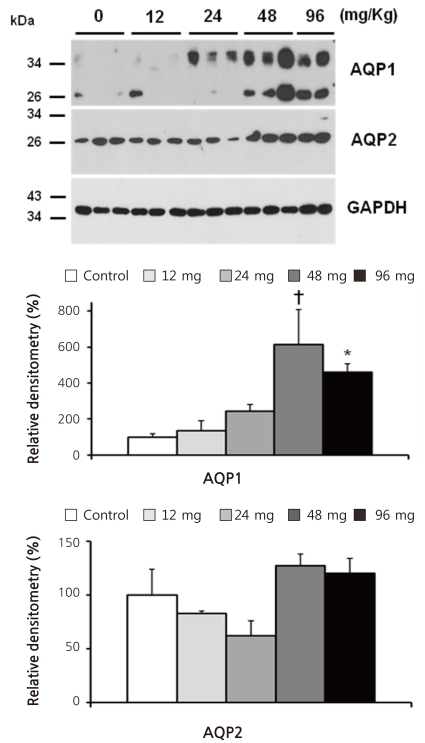
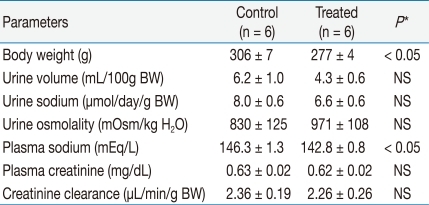
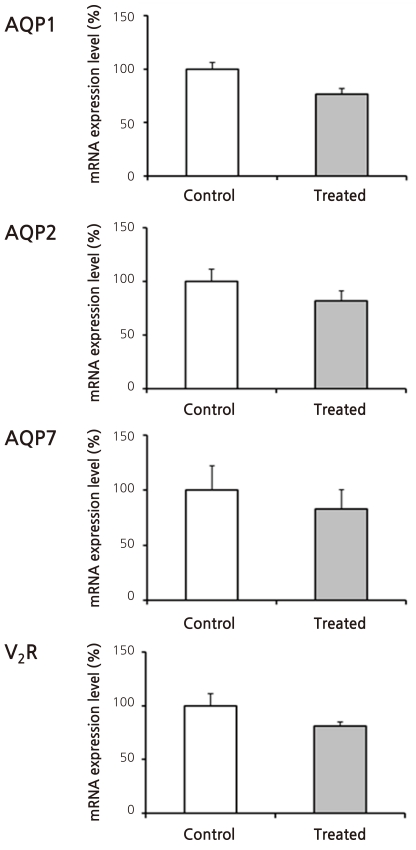
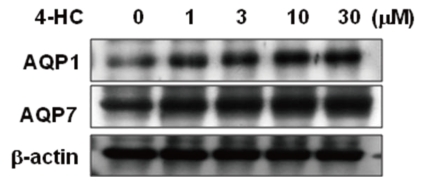
 XML Download
XML Download